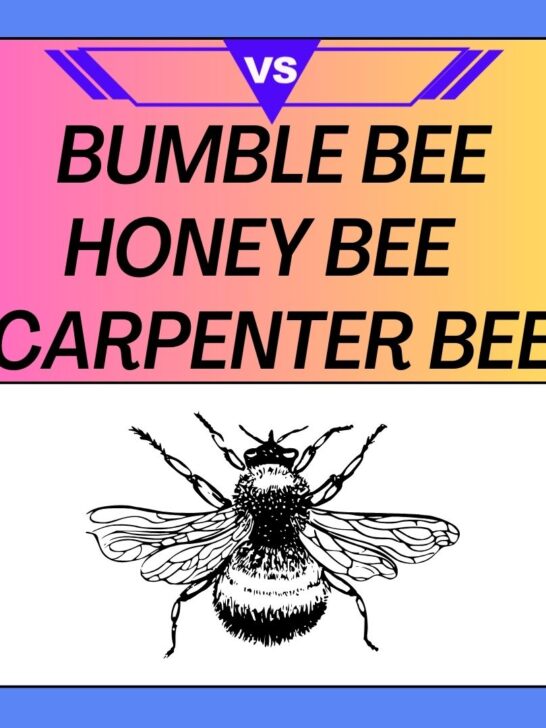Bumblebee vs. Honeybee vs. Carpenter Bee: A Comparative Guide: Bees are some of the most crucial pollinators on our planet, playing a vital role in ecosystems and agriculture. Among the thousands of bee species, bumblebees, honeybees, and carpenter bees are some of the most commonly encountered. While they all belong to the bee family, Apidae, these bees have distinct characteristics, behaviors, and roles in the environment. This comparative guide will explore the differences between bumblebees, honeybees, and carpenter bees.
Post Contents
Physical Characteristics
Bumblebees:
- Size: Bumblebees are generally larger and more robust than honeybees and carpenter bees.
- Color: They have vibrant, fuzzy bodies with black and yellow stripes, although some species can be black and orange.
- Hairiness: Bumblebees are exceptionally hairy, which helps them collect pollen.
- Legs: They have stout legs designed for gripping flowers while foraging.
Honeybees:
- Size: Honeybees are smaller and more slender compared to bumblebees.
- Color: They have distinct black and amber-colored bands on their bodies.
- Hairiness: Honeybees have less body hair than bumblebees.
- Legs: Their legs are adapted for collecting pollen, and they have pollen baskets on their hind legs.
Carpenter Bees:
- Size: Carpenter bees can be similar in size to bumblebees but have a more streamlined appearance.
- Color: They are typically black or blue-black with minimal hair.
- Hairiness: Unlike bumblebees, carpenter bees are less hairy.
- Legs: They have robust legs for drilling into wood.
Behavior and Nesting
Bumblebees:
- Social Structure: Bumblebees are social insects that live in colonies with a queen, workers, and drones.
- Nesting: They often nest in abandoned rodent burrows or holes in the ground. Their colonies are small compared to honeybee colonies.
Honeybees:
- Social Structure: Honeybees are highly social and live in large colonies with thousands of workers and a single queen.
- Nesting: They build intricate wax combs within hives or hollow tree trunks.
Carpenter Bees:
- Social Structure: Carpenter bees are generally solitary insects, although some species may have communal nests.
- Nesting: They bore into wood, creating tunnels where they lay their eggs. These tunnels can cause structural damage to wooden structures.
Pollination
Bumblebees:
- Foraging: Bumblebees are excellent pollinators for various plants, including those with complex flowers.
- Buzz Pollination: They use “buzz pollination,” a unique technique that dislodges pollen from certain flowers by vibrating their flight muscles at a specific frequency.
Honeybees:
- Foraging: Honeybees are efficient and versatile pollinators, visiting a wide range of flowers.
- Dance Language: They communicate the location of food sources to other workers through the famous “waggle dance.”
Carpenter Bees:
- Foraging: Carpenter bees primarily visit open-faced flowers but are less effective at pollinating complex flowers.
- Pollination: While they do pollinate some plants, they are not considered as effective pollinators as bumblebees or honeybees.
Stinging Behavior
Bumblebees:
- Defensive Stingers: Bumblebees are generally docile but will sting if they perceive a threat to their nest. Their stingers lack barbs, allowing them to sting multiple times.
Honeybees:
- Defensive Stingers: Honeybees can be defensive of their hives and will sting to protect them. Their stingers have barbs, which can become lodged in the skin, causing the bee to die after stinging.
Carpenter Bees:
- Males are Non-Aggressive: Male carpenter bees do not have stingers and are not aggressive.
- Females can Sting: Females have stingers but are less likely to sting unless provoked. Their stingers are not barbed like honeybees.
Economic Significance
Bumblebees:
- Agriculture: Bumblebees are essential pollinators for various crops, including tomatoes, peppers, and blueberries.
Honeybees:
- Agriculture: Honeybees are crucial pollinators for many crops, such as almonds, apples, and melons. They are also kept for honey production.
Carpenter Bees:
- Wood Damage: While carpenter bees have some role in pollination, they are more known for causing structural damage to wooden buildings.
Conclusion
Bumblebees, honeybees, and carpenter bees are distinct bee species with varying sizes, behaviors, and ecological roles. Bumblebees are robust pollinators with unique buzz pollination abilities, honeybees are efficient and social pollinators vital for agriculture, and carpenter bees while contributing to pollination, are notable for their wood-boring behavior. Understanding these differences is essential for appreciating the diverse world of bees and their significance in our ecosystems.

94% of pet owners say their animal pal makes them smile more than once a day. In 2007, I realized that I was made for saving Animals. My father is a Vet, and I think every pet deserves one. I started this blog, “InPetCare”, in 2019 with my father to enlighten a wider audience.
